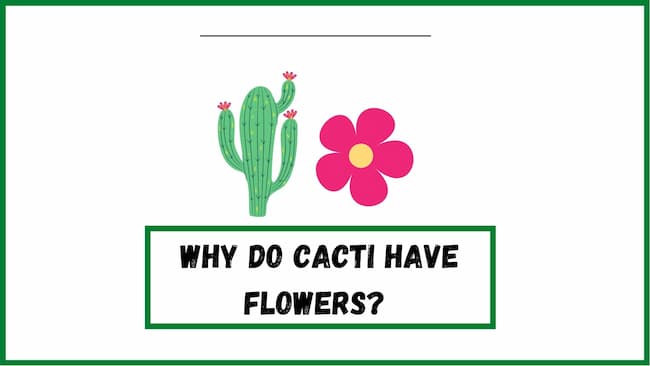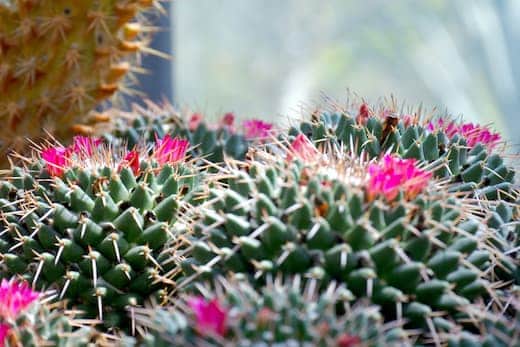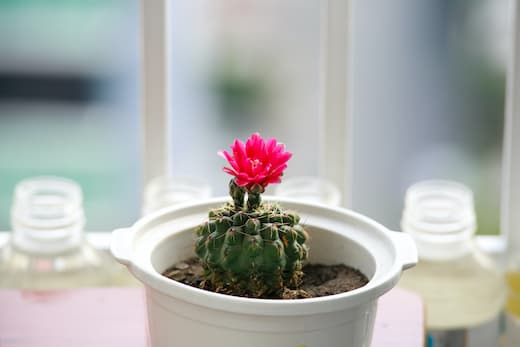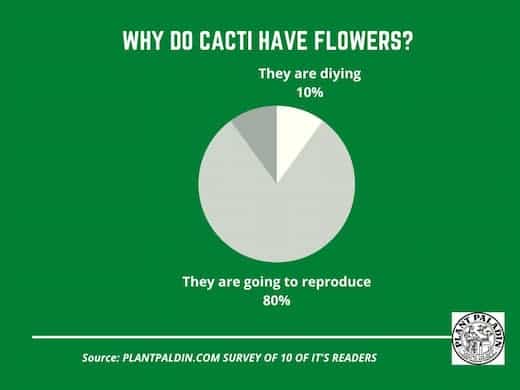This website is supported by its readers. If you click one of my links I may earn a commission. I am also a participant in the Amazon affiliates program and I will also earn a commission from qualified purchases.

One of the most common indoor plants is cacti. While these plants look very different from other indoor trees, such as Ficus, Elms, and Dracaena, they are still plants. One thing I was shocked by when looking at my cacti was the tiny flower that started appearing. So why do cacti have flowers?
Cacti have flowers that bloom to help reproduce. In the wild, birds, bees, and other insects are attracted to the bright-colored flowers and pollinate them, which produces fruit and new Cacti seeds. All Cacti produce flowers if grown in the proper condition.
As Columnar Cacti are relatively slow growing, it can take decades for these cacti first to bloom flowers or for the flowers to reappear once again.
So what species of cacti produce flowers? And what can you do to ensure that your Cactus has flowers? Keep reading to find out more!
Just a quick heads up, over the past three years of running Plantpaladin, hundreds of people have asked for product recommendations. As such, You can find my favorite indoor bonsai tree here (link takes you to Bonsaiboy), my favorite outdoor bonsai tree (link takes you to Bonsaiboy), or have a look at all the products I recommend here.
Why do cacti have flowers?
So while my Cacti produced flowers in the past, I didn’t just want to assume why.
As such, I contacted a few succulent specialists, visited my local botanical gardens, and even surveyed ten plant paladin readers who own Cacti to understand why Cacti have flowers.
To summarize:
- The main reason Cacti have flowers is for sexual reproduction.
- Cacti typically reproduce sexually and asexually.
- If your Cactus can reproduce, it will bloom bright flowers, attracting insects, small birds, and small mammals such as squirrels, pollinating the stigma of the flowers.
- This, in turn, fertilizes the Cactus, which will produce fruit to grow from the flower, which, when cracked, creates new cactus seeds.
- Most cactus flowers are located at the top of the succulent – this is to help animals help pollinate the flower, making them easier to get to without having to step on the prickly leave of the Cacti.
- Most Cacti, however, only produce a handful of large flowers instead of many tiny flowers dotted across the tree.
- Typically, Cacti species that produce bright flowers and blooms include flowers include Mammillaria, Gymnocalycium, Parodia cactus, and Angel Wing Cactus.
- All Cacti species can produce flowers if the right conditions are kept for the individual tree.
How do cacti flowers help with reproduction?
The main reason cactus flowers exist is for sexual reproduction.
Historically there have been two main ways to reproduce new cacti:
- Sexual reproduction.
- Asexual reproduction.
Asexual reproduction is more common in purpose-created indoor Cacti.
It is undertaken when a cutting is taken from the mother cactus and then grown as a clone version of the original tree.
Sexual reproduction, however, is much more common in the wild and is where the flowers come in.
These bright flowers contain two main assets vital for sexual reproduction.
- Pollen
- A stigma
Bees, insects, small birds, and small mammals are attracted by the bright flowers these trees produce.
They then typically gather the pollen from the flowers.
Then when they visit the flower of another cactus tree, the pollen they have picked up will pollinate the tree through pollen touching and fertilizing the stigmata.
All in all, the bright flowers these cacti produce are essential for sexual reproduction.

What does a blooming cactus mean?
A blooming cactus typically means your cacti are getting ready to reproduce sexually. Only cacti cared for adequately with correct water, soil, and sunlight requirements will bloom. An excellent general rule is that if your Cactus is in good health, it is in bloom.
What species of cactus produce flowers?
All cactus species produce flowers which are essential for sexual reproduction. Cacti species known for blooming include Mammillaria, Gymnocalycium, Parodia cactus, and Angel Wing Cactus.
Only mature, healthy cacti, however, will produce flowers.
To go into more detail on these cacti, I’ve enclosed a table below comparing these.
Species | Description |
Mammillaria | Several bright pink and white flowers located at the top of the cactus |
Gymnocalycium | One to 3 large pink, red or orange flowers located on the top of the cactus |
Parodia cactus | Several medium-sized pink, white, yellow, or red flowers located at the top of the cactus |
Angel wing cactus | Several pink and yellow flowers located on the top of the leaves of the cacti. |
Cactus type and flowering
Cacti are divided into three main sub-categories:
- Columnar cacti
- Short stem cacti
- Round cacti.
Each of these will produce different types of flowers at different yields.
Columnar cacti
These are long thin cacti.
Think of a western movie, and these are the cacti you will likely think of.
While most of us will not have seen these cacti with flowers on them, they bloom.
The major challenge with these cacti blooming is that if grown from seed, these trees can take 40 to 50 years before their first bloom.
To ensure these cacti bloom, cut from columnar cacti that are already in bloom, as the fresh cutting will start to bloom as soon as it has settled in its new pot.
If these trees are kept indoors in most mild climates, it is rare to get these cacti to bloom.
Short-stem cacti
These Cacti are species that have stems smaller than two feet.
The good news is that these cactus subspecies will bloom much faster and typically produce their first flowers after about five years.
Due to their classification, many different subspecies of cacti will fall under the short stem sub-category, and the flowers’ style and sizes can be just as varied.
Easter Lilly cacti, for example, produce bright white, red, pink, and magenta flowers.
Round Cacti
Cacti that fall into this category produce many flowers.
Most round cacti will typically produce flowers within their first 3 to 4 years if grown in suitable environments.
These flowers will typically also be more prominent, meaning if you want to invest in a cactus with flowers, these will be your best bet.
Cactus category | Time until first bloom | Examples of species |
Columnar cacti | 40 years+ if growing from seed | African milk tree, Saguaro, Peruvian apple cactus, Senita cactus |
Short Stem Cactus | 4 to 5 years | Easter Lilly, hedgehog cactus, peanut cactus, |
Round Cactus | 3 to 4 years | Pincushion cacti, Rebutias, |
When do cactus flowers bloom?
Most common household cactus species will bloom once per year during the spring or summer. Hedgehog cactus, for example, blooms between February and May. The exact timings of bloom timing depend on the subspecies. Christmas cacti, for example, will start to bloom during the fall/ winter.
How old do cacti need to be to bloom flowers?
Cacti need to reach maturity before producing flowers. Short-stem cacti will start producing cacti after five years, and round Cacti will produce flowers after 3 to 4 years. Columnar cacti typically will start producing flowers after 40 years.
Where are the flowers located on the cacti?
Flowers on the cacti are located on the top of the Cactus. This allows for easy access by animals that can help pollinate the plant. Most cacti produce several large flowers as opposed to dozens of tiny flowers.
Some subspecies, however, such as angel wing cacti, produce flowers on the plant’s leaves.


How long do blooms on cacti last?
The exact amount of time your cacti will bloom depends on the species of cacti. Most cactus plants will bloom flowers between one day and up to 6 weeks. It is rare for cacti to flower for more extended periods. Typically, however, the most common indoor cacti, such as hedgehog cactus, will bloom for 3 to 7 days.
Do cacti flowers attract bugs?
Cacti flowers, by design, are used to attract bugs, insects, and birds to help pollinate the plant. As such, many cactus flowers can also attract pests such as aphids or spider mites that can also attack your cacti. To avoid this, use organic pesticides such as predatory wasps that can pollinate your Cactus and attack pests simultaneously.
Now, if you are struggling with pests attacking your Cactus ( or any other tree or plant type, for that matter), I’d recommend looking at my post, which you can check out here.
Should flowers on a cactus be a cause for concern?
Flowers on a cactus are not a concern at all. These flowers appear when the tree is ready for sexual reproduction.
Most flowers on columnar cacti are rare, so they may strike as a cause for concern.
Rest assured, however, that like all plants and trees, cacti produce flowers to help them procreate – even if it takes them a while between flowering for some cacti categories.
How to get your cacti to bloom?
So now we know that cacti do indeed have flowers and what their purpose is. Are there any quick tips you can implement to ensure or speed up your cacti’ blooming?
Thankfully The following can help:
- Provide enough sunlight
- Water regularly
- Withhold water for short periods
- Provide adequate potting soil
- Remove any pests or infections
- Induce a cold temperature
Let’s explore this in more detail:
Provide enough sunlight
Like all plants and flora, cacti get their food from adequate sunlight.
As such, if you starve them of the light they need, they will cease to function correctly.
Most cacti live in dry, bright climates, so if your Cactus is not getting enough sunlight, there is a good chance it will not bloom.
Aim for your Cactus to get 4 to 5 hours of direct sunlight daily. This will allow your cacti to function correctly without burning or drying out. If kept indoors, place your cacti on a south-facing window to ensure they get enough sunlight.
Consider investing in an artificial light source if you live in a colder, darker climate.
Water regularly
While most of us think Cacti require minimal water due to being an almost universal drought-proof plant, the truth is that these plants need water frequently to function.
Watering your cacti then will ensure they can absorb the vital moisture and nutrients from their soil for their overall longevity.
Without this water or nutrients, your Cactus will fail to bloom due to the lack of energy required.
Water your Cactus then once every one to two weeks, checking that the topsoil is dry before doing so. Consider watering with filtered or rainwater which will yield the best results and not have any harmful contaminants that tap or bottled water may contain.
Withhold water for short periods
Now, if you are adamant about your Cactus blooming flowers, then a little trick I came across has been to withhold water for a short period.
This is known more commonly as the Ferber method, whereby you withhold watering (and fertilizing) your cactus.
Aim to do this for 4 to 6 weeks for mature cacti to bloom, and your Cactus should start to produce flowers.
Provide adequate potting soil
Cactus soil is unique compared to other plants, so if you have just used bargain bucket potting soil used for regular houseplants, then this could be why your Cactus is failing to bloom.
For best results, ensure that your soil is porous, sandy, or has pebbles and excellent drainage and aeration qualities.
Too much water in the solid will cause your cacti roots to become waterlogged and overwatered, leading to root rot.
Ensure you also change the potting soil of your Cactus once every one to two years to ensure your tree remains as healthy as possible.
Remove any pests or infections.
One of the biggest reasons your Cactus might not bloom is that it has been infected by bugs or bacteria inhibiting its bloom.
To check for bugs, look for tiny black dots or white worms in the potting soil.
The most common insects that attack your Cactus include Aphids, whiteflies, mealy bugs, and spider mites.
Chemical pesticides will work very well but can further damage the leaves and flowers of your caucus if too much is used.
Instead, I recommend considering natural predatory insects such as wasps or ladybugs as a countermeasure.
Bacterial infections are less common in succulents; overwatering can easily lead to root rot and fungi.
Antifungal sprays will work best in this regard.
Ensure you dry and repot your Cactus first to help remove excess moisture.
Induce a cold temperature
One final method of getting your Cactus to bloom is temporarily lowering its surrounding temperature.
Some cacti need to enter a winter dormancy period to help conserve energy.
This will then allow them to push out flowers when they typically bloom in the spring and summer.
If you live in a mild climate year-round or keep your Cactus indoors without much of a temperature change, move it into the refrigerator for a few weeks and then gradually back into its normal temperature range.
This should prompt those species of Cactus that require cold stratification.
Just ensure the temperatures don’t drop below 20F for too long, as this will kill your Cactus.
Do cacti produce fruit?
Cacti produce fruit containing seeds that grow from the flowers they bloom. Some cacti produce edible fruit, such as prickly pear, which produces dragon fruit, or Hylocereus, which produces pitaya.
What conditions are needed for cacti to bloom flowers?
Cacti need at least 4 to 5 hours of direct sunlight, watering once every two weeks, slightly acidic soil, and fertilizing once per month in the spring to produce flowers. They also need to have reached maturity to bloom.
Cacti also need to pursue soil that allows water to easily flow through it to prevent the trees from becoming over-watered.
Is it rare for cacti to flower?
It is not rare for cacti to flower or bloom. Short-stem cacti and round Cacti bloom at least once yearly after reaching maturity ( typically after 4 to 5 years). Columnar cacti may take longer to blog, averaging 20 to 40 years before reaching maturity, so this may be a slightly rarer sight.
Should you let a cactus bloom?
You should not try to inhibit or prevent your Cactus from blooming. A blooming cactus is a natural part of your plant’s lifecycle and should be encouraged through active care.
Why do cacti have flowers – Survey results?
As mentioned previously, I didn’t want to give my insight, so I quickly surveyed ten plant paladin readers, asking them why their cacti bloom.
To summarize:

My top picks for the gear you will need!
So like I mentioned earlier, over the past three years of running PlantPaladin, hundreds of people have asked me for my recommendations on the best bonsai gear on the market.
Having spent thousands of dollars on bonsai items these past few years and tested at least 100 bonsai-specific products, I’ve listed my favorite products below – All of which I highly recommend and think you can get great value.
They can purchase directly by clicking the link to take them to Amazon.
Bonsai Tool Set: One of the significant challenges I’ve had is finding a toolset that was not only durable but didn’t break the bank. SOLIGT has recently developed a fantastic bonsai tool set that covers all the tools you need to trim, prune, and repot your trees. – You can grab it here.
Complete Bonsai Set: Many of you will want to grow your bonsai trees entirely from scratch, but finding the varicose seeds, pots, and other items in one place can be challenging. Leaves and Sole then have created a complete bonsai set that I’ve personally used that ticks all the boxes. You can grab it here.
Bonsai wire: The number of times I’ve run out of wire for my bonsai or purchased cheap bonsai wire that doesn’t do the job is embarrassing for me to admit. After a lot of trial and error, I found that using Hotop’s aluminum bonsai wire is one of the best options on the market. This can easily be used for both indoor and outdoor bonsai. You can grab it here.
This post was written by Fehed Nicass, who has been passionate about bonsai for over three years.
